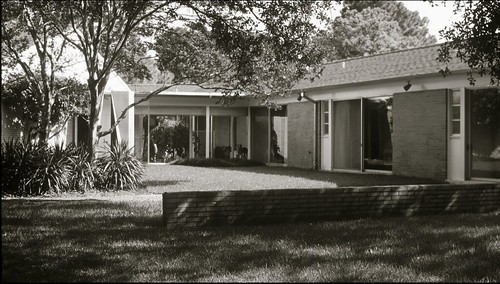In 1994 Tulane School of Architecture sponsored a tour, "The International Style in New Orleans" which featured six modern buildings designed by alumni and faculty in New Orleans: Nathaniel C. Curtis, Jr., Arthur Q. Davis, John Lawrence, James Lamantia, Albert C. Ledner, and August Perez, Jr. This is the fifth of six posts in a series.
Mossy/ Swartz-Johnson House
28 Tern Street
Architectural Firm: Lawrence, Saunders and Calongne
Principal Architect: John Lawrence
28 Tern Street
Architectural Firm: Lawrence, Saunders and Calongne
Principal Architect: John Lawrence
This home, built in 1956-57, reveals the genius of John Lawrence, a former Dean of the Tulane School of Architecture and a proponent of the view that “ good modern architecture is not a set of standard forms... it is an architecture which welcomes the entire range of building materials.” A native of Louisiana, Lawrence incorporated elements of traditional local architecture as well.
Beginning with a fairly small wedge-shaped lot, he created a feeling of spaciousness by aligning the two wings of the home with the edge of the lot and by creating walls of glass that open onto a park-like view that then included Lake Pontchartrain.
Lawrence believed that building facades should not overwhelm a neighborhood. In this case the shape of the lot militated against that excess. From the street only the carport and an iron grille are visible. The carport bears a flat roof, a hallmark of International-Style inspired buildings.
Each of the two wings has a different function and feel. The cozy bedroom wing includes two baths with their original tiles and fixtures and the two bedrooms with glass walls. The utilities, housed at the other end of the wing, form a separate unit. In the larger wing, dedicated to public life, interior walls are partitions that do not obstruct the view of the roof, which seems to defy gravity, rising to 18 feet. A bank of skylights enhances the openness. Storage space lines the bedroom hall, dining room and kitchen. The Decorative elements are subtle and carefully chosen. Molding, of either wood or plaster, is absent. Doors are generally unadorned; exceptions include the sliding door between the den and the entrance hall and the metal grille work. The massive fireplace and its matching coffee table, of Travertine marble, were designed by Lawrence.
The home complements the owners furniture and art collection dating to the Art Deco period, the 1940’s through 1960’s, and the contemporary era.
________________________________________________
The International Style in New Orleans, Tulane School of Architecture, 1994, copy by Patty Andrews
photo: Lauren Polhamus


No comments:
Post a Comment